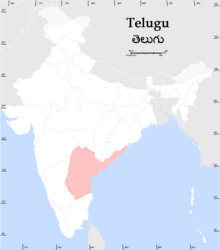Telugu
| Telugu ( తెలుగు ) | ||
|---|---|---|
|
Spoken in |
India ( Andhra Pradesh , Telangana and neighboring states) | |
| speaker | 81 million | |
| Linguistic classification |
|
|
| Official status | ||
| Official language in | India , states of Andhra Pradesh and Telangana | |
| Language codes | ||
| ISO 639 -1 |
te |
|
| ISO 639 -2 |
tel |
|
| ISO 639-3 |
tel |
|
Telugu ( తెలుగు ) is a language from the Dravidian language family . It is spoken by 81 million people in South India . This makes Telugu the largest Dravidian language and, after Hindi , Bengali and Marathi, the language of India with the fourth most speakers.
Distribution and number of speakers
The range of the Telugu largely coincides with the Indian states of Andhra Pradesh and Telangana . It also serves as the official language in the two states. In addition, Telugu is recognized as one of 22 constitutional languages in India on a supraregional level .
According to the 2011 Indian census, Telugu is spoken by 81 million people as their mother tongue. Almost 71 million of them live in the former state of Andhra Pradesh (including Telangana, which only split off as an independent state in 2014). Larger Telugu-speaking minorities can also be found in the neighboring federal states of Tamil Nadu (4.2 million), Karnataka (3.6 million) and Maharashtra (1.3 million).
Language history
An inscription from the year 575 is considered the oldest language certificate of Telugu.
The oldest literary work is a rewrite of part of the Mahabharata epic from the 11th century. According to tradition, the author of this work also wrote the first Telugu grammar in Sanskrit with the title Andhrashabdachintamani . Similar to the other Dravidian literary languages, Telugu has been heavily influenced by Sanskrit, the classical language of Hinduism .
In the early 20th century, written and spoken Telugu formed two almost completely different languages. After long battles between classics and modernists, a modernized form of written Telugu - more appropriately adapted to everyday language - is now almost universally used in scripts and the media.
Characteristics
The Telugu vocabulary has a large proportion of loan words from Sanskrit.
The grammar has a number of peculiarities. For example, the contrast between affirmative and negative verbs is built into some verb forms: ammutadu (he sells) and ammadu (he does not sell).
There are two gender groups: in the singular, a distinction is made between masculine on the one hand and feminine plus non-human on the other. In the plural, however, feminine and masculine are combined in one group, non-human nouns in the second group.
Telugu script
Like many Indian languages, Telugu has its own script, the Telugu script . This is very similar to the Kannada script and belongs to the family of Indian scripts . It shares the common origin of the Brahmi script from the 3rd century BC with the other scriptures of India, Tibet and Southeast Asia . Chr. And a common functional principle: They are an intermediate form of alphabet and syllabary, so-called Abugidas , in which each consonant sign has an inherent vowel a , which can be modified by diacritical marks . Typically for a South Indian script, the Telugu script is characterized by its round shapes.
additional
Telugu Talli is considered to be the personification of language.
literature
- Bhadriraju Krishnamurti: "Telugu". In: Sanford B. Steever (Ed.): The Dravidian Languages. London 1998, pp. 202-240, ISBN 0-415-10023-2 .

